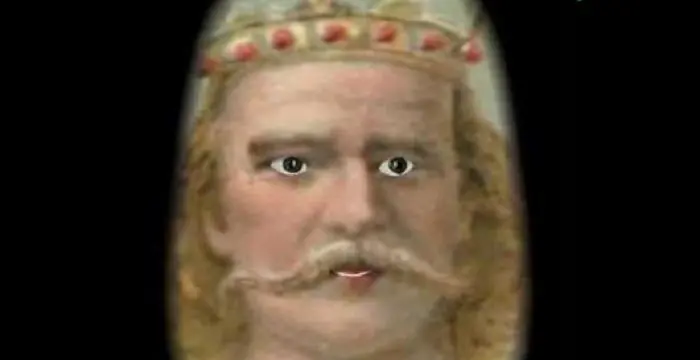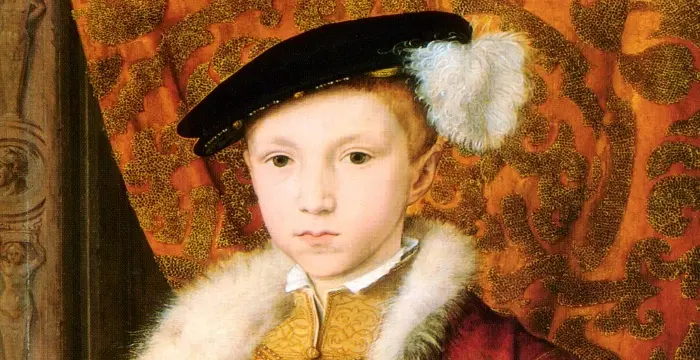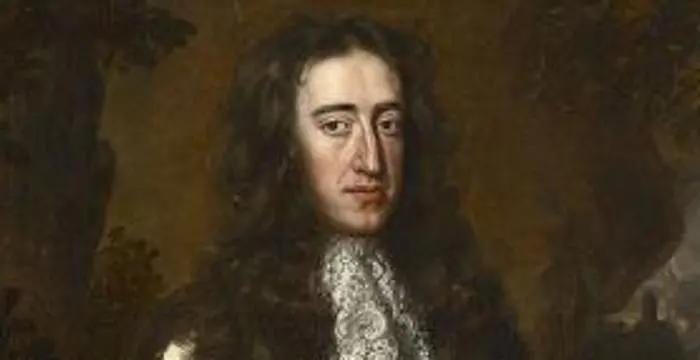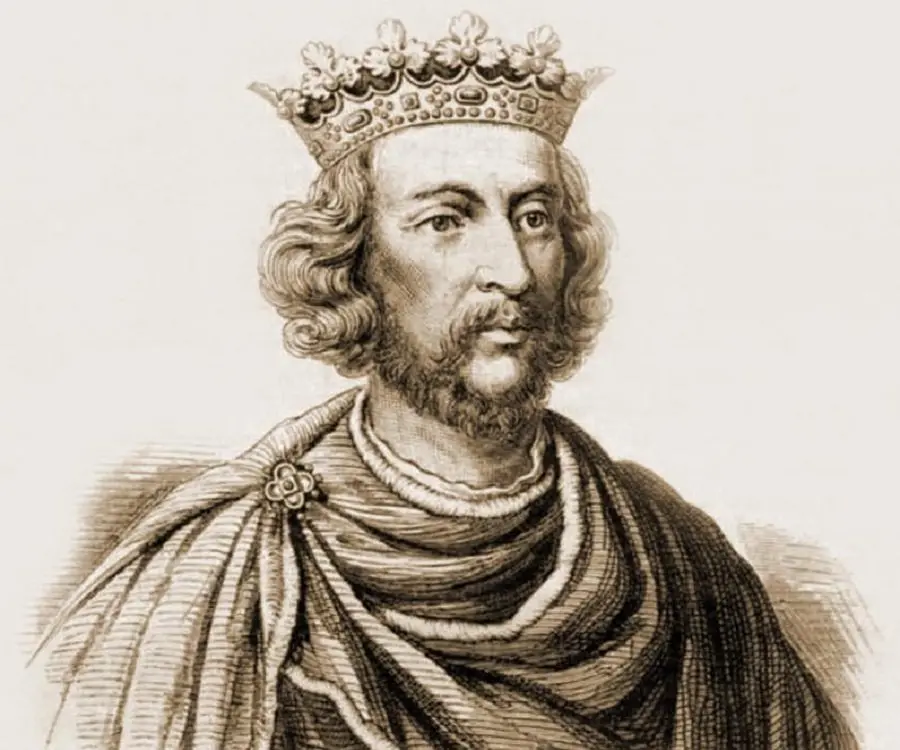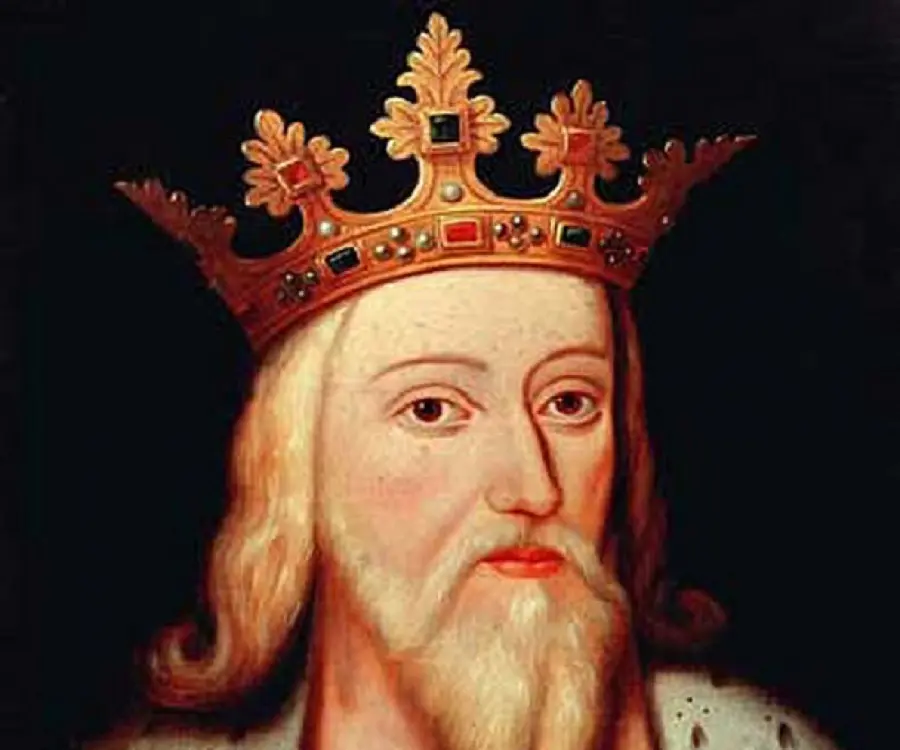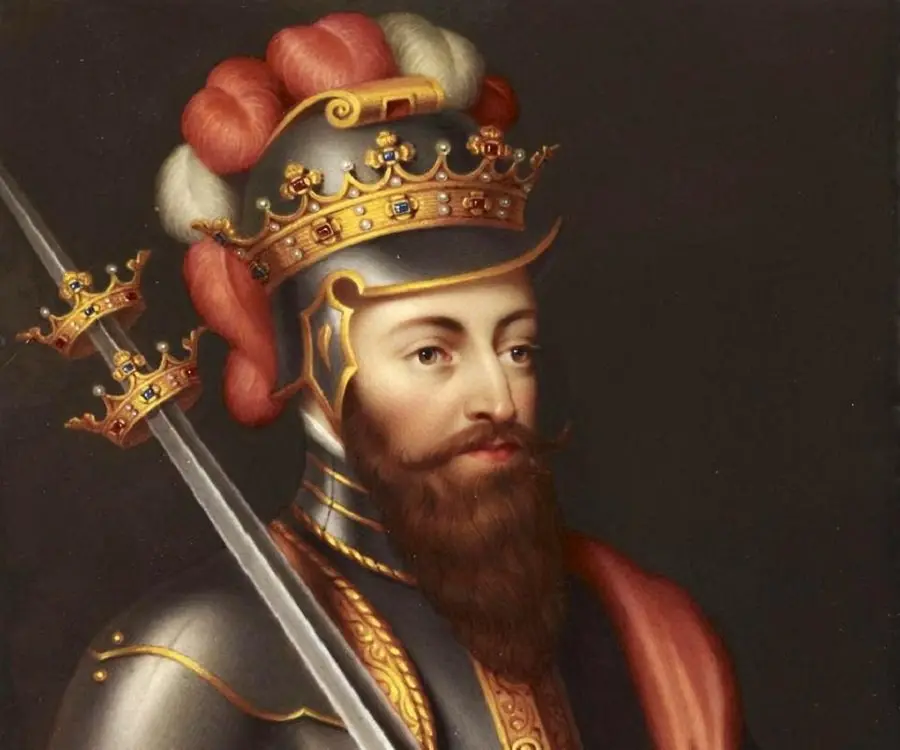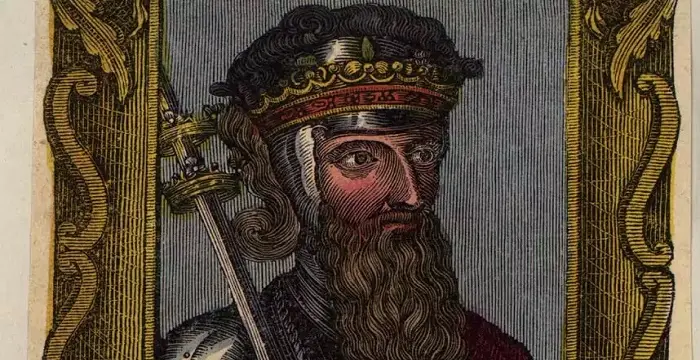
Edward III of England - Emperors, Birthday and Childhood
Edward III of England's Personal Details
King Edward III was the of England who commenced the Hundred Years’ War against France
| Information | Detail |
|---|---|
| Birthday | November 13, 1312 |
| Died on | June 21, 1377 |
| Nationality | British |
| Famous | Historical Personalities, Emperors & Kings, Emperors, King of England, Kings |
| Spouses | Philippa of Hainault |
| Siblings | Earl of Cornwall, Joan of the Tower, John of Eltham |
| Childrens | 1st Duke of Clarence, 1st Duke of Gloucester, 1st Duke of York, Countess of Bedford, Countess of Pembroke, Edmund of Langley, Edward, Isabella, Joan of England, John of Gaunt, Lionel of Antwerp, Margaret, Mary of Waltham, the Black Prince, Thomas of Woodstock |
| Founder / Co-Founder |
|
| Birth Place | Windsor Castle |
| Gender | Male |
| Father | Edward II of England |
| Mother | Isabella of France |
| Sun Sign | Scorpio |
| Born in | Windsor Castle |
| Famous as | King of England |
| Died at Age | 64 |
// Famous King of England
Harold Godwinson
Harold Godwinson was an Anglo Saxon King of England in the 11th Century. Check out this biography to know about his birthday, childhood, family life, achievements and fun facts about him.
Edward VI of England
Edward VI served as the King of England, from 1547 until his death in 1553. Check out this biography to learn in details about his life, his works as a king and timeline
William III of England
William III was the stadtholder of the main provinces of the Dutch Republic and the king of England, Ireland, and Scotland (King William II of Scotland). Check out this biography to know more about his childhood, family, life history, etc.
Edward III of England's photo
Who is Edward III of England?
Edward III served as the King of England from 1327 until 1377. He came to power at the time when England was going through a difficult phase, with an inactive King who was keener on bestowing favours to his exclusive patronage rather than improving the condition of the country. King Edward III was charismatic and dominant. He transformed the Kingdom of England from the disastrous reign of his father into one of the most formidable military powers. He was commended for his military shrewdness and warfare aptitude. It was under his rule that the Hundred Years’ War commenced as his claim for being the rightful heir to the French throne was denied. The highlight of his career came at the Battle of Crecy when his tactical measures and military skills helped the heavily outnumbered English army to gain a resounding victory over the large French army. The victory at Crecy led to another one at Poitiers by his son, Edward, which finally culminated into the signing of the highly favourable Treaty of Brétigny, which secured English possession of French sovereignty in return for relinquishing his claim to the French throne. In addition to military achievements, King Edward III reign also witnessed vital developments in legislation and government. He also helped England safely sail through the ravages of the bubonic plague, Black Death
// Famous Emperors
Sundiata Keita
Sundiata Keita was the founder of the Mali Empire in West Africa. This biography profiles his childhood, early life, struggles, founding of empire, rule, administration, achievements and also gives some fun facts.
Ashoka
Ashoka was the third emperor of the Mauryan Dynasty and ruled almost the entire Indian subcontinent. This biography profiles his childhood, life, reign, achievements and timeline
Murad IV
Murad IV was one of the mighty Sultans in the history of the Ottoman Empire. This biography profiles his childhood, family, accession, rule, administration and timeline.
Childhood & Early Life
Edward III was born to King Edward II and Queen Isabella of France on November 13, 1312 at Windsor Castle. He was popularly referred to as Edward of Windsor.
Merely 12 days old, Edward III was bequeathed with the title Earl of Chester by his father, King Edward II. The appointment was essentially made to boost the prestige of the young prince.
Accession & Reign
In 1325, young Edward III accompanied his mother to perform homage for the English Duchy of Aquitaine. It was during this trip that his mother befriended exiled Roger Mortimer. Together with Mortimer, she planned to depose King Edward II and instead crown her son.
In France, Prince Edward was engaged to the twelve-year-old Philippa of Hainault. The association was merely done to build up diplomatic and military support. Following the invasion of England and dethronement of his father, he was crowned as King of England on February 1, 1327
Since Edward III was too young to rule as the King of England, Roger Mortimer served as the de-facto ruler of England. During the latter’s reign, England not just faced a humiliating defeat by the Scots at the Battle of Stanhope Park but had to sign the Treaty of Edinburgh-Northampton which secured Scotland the status of an independent nation.
Relations between Mortimer and Edward III were not too good. They only worsened with time following Edward III’s marriage to Philippa and the birth of their son. Resenting Mortimer’s political position and interference with the government, Edward III premeditated Mortimer’s execution.
Following Mortimer’s death, Edward III began to rule and reign in real. His foremost aim was to rebuild England into a powerful nation that it had once been under his grandfather Edward I. He repudiated the Treaty of Northampton and with that declared the War with Scotland.
In the early 1330s, England’s relation with France turned hostile, primarily due to the ongoing dispute of the English rule of Gascony. Adding fuel to fire was French king, Philip VI’s support to the Scots, Edward III’s alliance with Flemish and the revival of Edward’s claim to the French crown as the maternal grandson of King Philip IV.
According to the Salic law of succession, King of France, Philip VI received support of the nation, thus rejecting Edward III’s claim to the throne. It was this rejection that laid the foundation for the Hundred Years’ War against France.
Between 1339 and 1340, King Edward III twice attempted to invade France from the north, but failed each time leading to bankruptcy. The only victory of this phase of war was the English naval victory at Sluys, which secured them control of the English Channel.
A new phase of the war began in 1346 when King Edward III landed in Normandy along with his son Prince Edward (popularly called Black Prince). He defeated the King of France, King Philip VI at the Battle of Crecy. The decisive victory at Crecy scattered the French army. At this battle that his son, Black Prince famously won his spurs.
In 1346, he celebrated victories at Gascony and Brittany. David, King of Scots, was also defeated and taken prisoner at Nevilles Cross, near Durham thus re-emphasizing King Edward III’s powers as a leader and campaigner.
Following his victory at Crecy, he ventured forth and laid siege at the French port of Calais. A year later English army gained control over Calais in August 1347. Edward III colonized the town of Calais with Englishmen, ousting almost all French inhabitants and established it as the English base for future invasions of France.
Monetary constraint was a constant hindrance for King Edward III. It led him to make a new truce in September 1347. Following this, he returned to England wherein he established his scheme for the Order of the Garter. In 1348, he rejected the offer of the imperial throne by the Holy Empire.
In 1348, England was struck by the horrific and dreadful bubonic plague, Black Death. Raging until 1349, the plague killed a vast population but before a full-scale breakdown could occur, the recovery was made.
War resumed in 1355 on a larger scale. The following year, his son, Black Prince made a resounding victory at the Battle of Poitiers, capturing the new French king, John II. Unable to pay the ransom demanded, King John II submitted himself to English custody.
England had an upper hand over France at the end of the first phase of the Hundred Years’ War. Peace was negotiated by the Treaty of Bretigny, according to which, King Edward III renounced his claim to the French crown in exchange for the whole of Aquitaine, Poitiers and Calais to be retained by England.
King Edward III’s later reign following the end of the first phase of war was dominated by a period of political strife and military ineffectiveness. Things at the administrative front also saw upheaval as inexperienced subordinates made majority of the decisions.
In 1369, when French declared war on English, King Edward III showed little vigour, enthusiasm and passion as compared to his earlier military campaign. He took up the title of the King of France but left responsibility of the military actions and administrative policies to his sons, Edward and John of Gaunt.
In 1375, English efforts to restore their possession of France failed miserably. Treaty of Bruges was signed according to which the English possession of France was limited to coastal areas of Calais, Bordeaux and Bayonne.
During the last years of King Edward III’s rule, Black Prince and John of Gaunt became leaders of the divided parties in the court and the king’s council. With the help of the King’s mistress, Alice Perrers, John of Gaunt obtained influence over his father, and controlled the government of the kingdom.
Following the illness of King Edward III and death of Prince Edward, John of Gaunt gained full control of the government.
Major Battles
While King Edward III fought many battles during the Hundred Years’ War, the highlight of his military career came at the Battle of Crecy. Despite being heavily outnumbered, the English army under his able guidance, tactical measures and effective military and warfare skills gained a resounding victory over the large French army.
King Edward III’s victory at Crecy was soon followed by that of his son at the Battle of Poitiers. Eventually, the Treaty of Brétigny was signed according to which King Edward III secured possession of French sovereignty in return for relinquishing his claim to the French throne.
Personal Life & Legacy
Prince Edward was engaged to the twelve-year-old Philippa of Hainault. Their marriage took place on January 24, 1348. They had twelve children, seven sons and five daughters.
Following the death of Queen Philippa in 1369, King Edward III came under the influence of his mistress Alice Perrers, a corrupt and immoral woman.
In June 1376, his son Edward was stricken with illness that cost him his life. Later the same year, King Edward III suffered from an abscess. He never fully recovered from the condition. A stroke on June 21, 1377 led to his death.
He was buried at Westminster Abbey. He was succeeded by his ten year old grandson of Edward, Richard II.
// Famous Kings
Sundiata Keita
Sundiata Keita was the founder of the Mali Empire in West Africa. This biography profiles his childhood, early life, struggles, founding of empire, rule, administration, achievements and also gives some fun facts.
Ashoka
Ashoka was the third emperor of the Mauryan Dynasty and ruled almost the entire Indian subcontinent. This biography profiles his childhood, life, reign, achievements and timeline
Murad IV
Murad IV was one of the mighty Sultans in the history of the Ottoman Empire. This biography profiles his childhood, family, accession, rule, administration and timeline.
Edward III of England biography timelines
- // 13th Nov 1312Edward III was born to King Edward II and Queen Isabella of France on November 13, 1312 at Windsor Castle. He was popularly referred to as Edward of Windsor.
- // 1325In 1325, young Edward III accompanied his mother to perform homage for the English Duchy of Aquitaine. It was during this trip that his mother befriended exiled Roger Mortimer. Together with Mortimer, she planned to depose King Edward II and instead crown her son.
- // 1st Feb 1327In France, Prince Edward was engaged to the twelve-year-old Philippa of Hainault. The association was merely done to build up diplomatic and military support. Following the invasion of England and dethronement of his father, he was crowned as King of England on February 1, 1327
- // 1339 To 1340Between 1339 and 1340, King Edward III twice attempted to invade France from the north, but failed each time leading to bankruptcy. The only victory of this phase of war was the English naval victory at Sluys, which secured them control of the English Channel.
- // 1346A new phase of the war began in 1346 when King Edward III landed in Normandy along with his son Prince Edward (popularly called Black Prince). He defeated the King of France, King Philip VI at the Battle of Crecy. The decisive victory at Crecy scattered the French army. At this battle that his son, Black Prince famously won his spurs.
- // 1346In 1346, he celebrated victories at Gascony and Brittany. David, King of Scots, was also defeated and taken prisoner at Nevilles Cross, near Durham thus re-emphasizing King Edward III’s powers as a leader and campaigner.
- // Aug 1347Following his victory at Crecy, he ventured forth and laid siege at the French port of Calais. A year later English army gained control over Calais in August 1347. Edward III colonized the town of Calais with Englishmen, ousting almost all French inhabitants and established it as the English base for future invasions of France.
- // Sep 1347 To 1348Monetary constraint was a constant hindrance for King Edward III. It led him to make a new truce in September 1347. Following this, he returned to England wherein he established his scheme for the Order of the Garter. In 1348, he rejected the offer of the imperial throne by the Holy Empire.
- // 1348 To 1349In 1348, England was struck by the horrific and dreadful bubonic plague, Black Death. Raging until 1349, the plague killed a vast population but before a full-scale breakdown could occur, the recovery was made.
- // 24th Jan 1348Prince Edward was engaged to the twelve-year-old Philippa of Hainault. Their marriage took place on January 24, 1348. They had twelve children, seven sons and five daughters.
- // 1355War resumed in 1355 on a larger scale. The following year, his son, Black Prince made a resounding victory at the Battle of Poitiers, capturing the new French king, John II. Unable to pay the ransom demanded, King John II submitted himself to English custody.
- // 1369In 1369, when French declared war on English, King Edward III showed little vigour, enthusiasm and passion as compared to his earlier military campaign. He took up the title of the King of France but left responsibility of the military actions and administrative policies to his sons, Edward and John of Gaunt.
- // 1369Following the death of Queen Philippa in 1369, King Edward III came under the influence of his mistress Alice Perrers, a corrupt and immoral woman.
- // 1375In 1375, English efforts to restore their possession of France failed miserably. Treaty of Bruges was signed according to which the English possession of France was limited to coastal areas of Calais, Bordeaux and Bayonne.
- // Jun 1376 To 21st Jun 1377In June 1376, his son Edward was stricken with illness that cost him his life. Later the same year, King Edward III suffered from an abscess. He never fully recovered from the condition. A stroke on June 21, 1377 led to his death.
// Famous Historical Personalities
Sundiata Keita
Sundiata Keita was the founder of the Mali Empire in West Africa. This biography profiles his childhood, early life, struggles, founding of empire, rule, administration, achievements and also gives some fun facts.
Ashoka
Ashoka was the third emperor of the Mauryan Dynasty and ruled almost the entire Indian subcontinent. This biography profiles his childhood, life, reign, achievements and timeline
Jetsun Pema
Jetsun Pema is the Queen consort of Bhutan. Check out this biography to know about her childhood, family life, achievements and fun facts about her life.
Murad IV
Murad IV was one of the mighty Sultans in the history of the Ottoman Empire. This biography profiles his childhood, family, accession, rule, administration and timeline.
Xerxes I
Xerxes I (Xerxes the Great) was the fourth and the most famous king of the Archaemenid dynasty of Persia. This biography profiles his childhood, family, personal life, life history, achievements, campaigns, administration, death and other facts.
Sargon of Akkad
Sargon of Akkad, also called ‘Sargon the Great’, ‘Sarru-Kan’ and ‘Shar-Gani-Sharri’, was the founder and first king of the Akkadian Empire. This biography profiles his childhood, life, rule, administration, timeline, and gives some fun facts.
Edward III of England's FAQ
What is Edward III of England birthday?
Edward III of England was born at 1312-11-13
When was Edward III of England died?
Edward III of England was died at 1377-06-21
Where was Edward III of England died?
Edward III of England was died in Richmond Palace
Which age was Edward III of England died?
Edward III of England was died at age 64
Where is Edward III of England's birth place?
Edward III of England was born in Windsor Castle
What is Edward III of England nationalities?
Edward III of England's nationalities is British
Who is Edward III of England spouses?
Edward III of England's spouses is Philippa of Hainault
Who is Edward III of England siblings?
Edward III of England's siblings is Earl of Cornwall, Joan of the Tower, John of Eltham
Who is Edward III of England childrens?
Edward III of England's childrens is 1st Duke of Clarence, 1st Duke of Gloucester, 1st Duke of York, Countess of Bedford, Countess of Pembroke, Edmund of Langley, Edward, Isabella, Joan of England, John of Gaunt, Lionel of Antwerp, Margaret, Mary of Waltham, the Black Prince, Thomas of Woodstock
Which company or organization was founded by Edward III of England?
Edward III of England was the founder/co-founder of St George's School, Windsor Castle
Who is Edward III of England's father?
Edward III of England's father is Edward II of England
Who is Edward III of England's mother?
Edward III of England's mother is Isabella of France
What is Edward III of England's sun sign?
Edward III of England is Scorpio
How famous is Edward III of England?
Edward III of England is famouse as King of England
